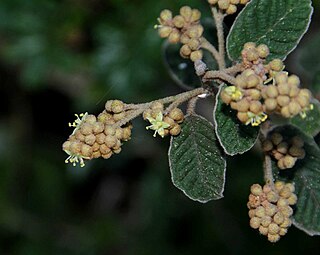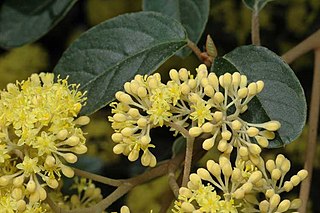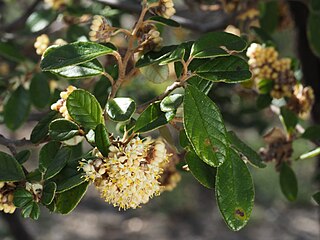
Pomaderris aspera, commonly known as hazel pomaderris, is a species of flowering plant in the family Rhamnaceae and is endemic to south-eastern Australia. It is a shrub or small tree with elliptic to lance-shaped or egg-shaped leaves and greenish-yellow flowers.

Pomaderris intermedia, commonly known as lemon dogwood, is a species of flowering plant in the family Rhamnaceae and is endemic to south-eastern Australia. It is a shrub with hairy stems, elliptic to egg-shaped leaves, and clusters of yellow flowers.

Pomaderris oraria, commonly known as Bassian dogwood, is a species of flowering plant in the family Rhamnaceae and is endemic to south-eastern Australia. It is a compact shrub with hairy branchlets, hairy, elliptic leaves and panicles of hairy, greenish to cream-coloured or crimson-tinged flowers.

Pomaderris paniculosa, commonly known as scurfy pomaderris, is a species of flowering plant in the family Rhamnaceae and is native to Australia and New Zealand. It is a shrub with hairy branchlets, round to elliptic or egg-shaped leaves with the narrower end towards the base and panicles of hairy, cream-coloured to greenish, sometimes crimson-tinged flowers.

Pomaderris elliptica, commonly known as yellow dogwood or smooth pomaderris, is a species of flowering plant in the family Rhamnaceae and is endemic to south-eastern Australia. It is a shrub with densely hairy branchlets, egg-shaped or elliptic leaves, and pale yellow flowerss.

Pomaderris mediora is a species of flowering plant in the family Rhamnaceae and is endemic to the central coast of New South Wales. It is a low-lying or erect shrub with hairy new growth, narrowly elliptic to lance-shaped leaves with the narrower end towards the base, and panicles of cream-coloured flowers.

Pomaderris andromedifolia is a species of flowering plant in the family Rhamnaceae and is endemic to south-eastern continental Australia. It is a shrub with lance-shaped to elliptic leaves and cream-coloured to yellow flowers.

Pomaderris betulina, commonly known as birch pomaderris, is a species of flowering plant in the family Rhamnaceae and is endemic to south-eastern continental Australia. It is a shrub with hairy young stems, lance-shaped to oblong or elliptic leaves, and yellowish flowers.

Pomaderris bodalla, commonly known as Bodalla pomaderris, is a species of flowering plant in the family Rhamnaceae and is endemic to New South Wales. It is a shrub with hairy young stems, elliptic to more or less rhombic leaves, and dense clusters of cream-coloured flowers.
Pomaderris briagolensis is a species of flowering plant in the family Rhamnaceae and is endemic to Victoria, Australia. It is a shrub with hairy branchlets, egg-shaped or oblong leaves and panicles of white to rust-coloured flowers.

Pomaderris cocoparrana, commonly known as Cocoparra pomaderris, is a species of flowering plant in the family Rhamnaceae and is endemic to a restricted area of New South Wales. It is a shrub with hairy stems, egg-shaped to more or less round leaves, and clusters of yellow flowers.
Pomaderris coomingalensis is a species of flowering plant in the family Rhamnaceae and is endemic to Queensland. It is a shrub with hairy young stems, egg-shaped or elliptic leaves, and clusters of cream-coloured or yellow flowers.
Pomaderris crassifolia is a species of flowering plant in the family Rhamnaceae and is endemic to eastern Australia. It is a shrub with hairy young stems, egg-shaped or elliptic leaves, and clusters of cream-coloured or yellow flowers.

Pomaderris delicata, commonly known as delicate pomaderris, is a species of flowering plant in the family Rhamnaceae and is endemic to a restricted area of New South Wales. It is a shrub with hairy young stems, elliptic leaves, and clusters of golden-yellow flowers.
Pomaderris graniticola is a species of flowering plant in the family Rhamnaceae and is endemic to eastern Australia. It is a shrub or small tree with hairy young stems, lance-shaped to elliptic leaves, and sparse panicles of yellow, white or cream-coloured flowers.

Pomaderris helianthemifolia is a species of flowering plant in the family Rhamnaceae and is endemic to south-eastern continental Australia. It is a bushy shrub with hairy young stems, narrowly elliptic to lance-shaped leaves with the narrower end towards the base, and small panicles of hairy yellowish flowers.

Pomaderris phylicifolia, commonly known as narrow-leaf pomaderris, is a species of flowering plant in the family Rhamnaceae and is to south-eastern Australia and New Zealand. It is a slender shrub with hairy stems, narrowly egg-shaped to linear leaves, and small clusters of cream-coloured to yellow flowers.
Pomaderris precaria is a species of flowering plant in the family Rhamnaceae and is endemic to New South Wales. It is a slender shrub with hairy new growth, elliptic to lance-shaped leaves with the narrower end towards the base, and panicles of cream-coloured flowers.

Pomaderris reperta, commonly known as Denman pomaderris, is a species of flowering plant in the family Rhamnaceae and is endemic to a restricted area of New South Wales. It is a shrub with densely rusty-hairy new growth, egg-shaped to elliptic leaves, and dense panicles of cream-coloured flowers.
Pomaderris viridis is a species of flowering plant in the family Rhamnaceae and is endemic to south-eastern continental Australia. It is a shrub or small tree with hairy young stems, egg-shaped to elliptic leaves, and panicles of cream-coloured to pale yellowish-green flowers.














